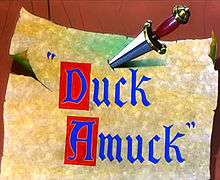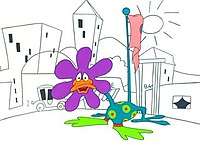Duck Amuck
Duck Amuck is a 1953 Warner Bros. Merrie Melodies cartoon directed by Chuck Jones.[1] The cartoon was released on February 28, 1953, and stars Daffy Duck.[2]
| Duck Amuck | |
|---|---|
 | |
| Directed by | Charles M. Jones |
| Produced by | Edward Selzer (uncredited) |
| Story by | Michael Maltese |
| Starring | Mel Blanc |
| Music by | Carl Stalling |
| Animation by |
|
| Layouts by | Maurice Noble |
| Backgrounds by | Philip DeGuard |
| Color process | Technicolor |
Production company | |
| Distributed by |
|
Release date |
|
Running time | 6:56 |
| Language | English |
In the cartoon, Daffy Duck is tormented by an unseen, mischievous animator, who constantly changes Daffy's locations, clothing, voice, physical appearance and even shape, much to Daffy's aggravation, embarassment and finally rage. Pandemonium reigns throughout the cartoon as Daffy attempts to steer the action back to some kind of normality, only for the animator to either ignore him or, more frequently, to over-literally interpret his increasingly frantic demands. In the end, the tormenting animator is revealed to be Bugs Bunny.
In 1994, it was voted #2 of The 50 Greatest Cartoons of all time by members of the animation field, losing only to What's Opera, Doc?, also directed by Chuck Jones and written by Michael Maltese.[3] In 1999, Duck Amuck was added to the National Film Registry for being "culturally, historically, or esthetically significant." [4] [5]
The short was included on the Looney Tunes Golden Collection: Volume 1 DVD box set (with optional audio commentary by Michael Barrier), The Essential Daffy Duck DVD box set, and the Looney Tunes Platinum Collection: Volume 1 Blu-ray box set. The short inspired the 2007 Nintendo DS game Looney Tunes: Duck Amuck.
Plot
The cartoon's title sequence and opening scene suggest Daffy Duck is to star as a musketeer, and he appears, boldly engaging in an action scene with a fencing foil. As he thrusts the foil and advances, the background abruptly disappears, leaving a plain white screen. Confused by this, Daffy turns to the animator and asks them to complete the scenery. However, instead of a castle from the original scene, the animator paints a farm scene. Daffy returns and starts to repeat his musketeer opening, but quickly notices the different background. He walks off screen and returns dressed as a farmer, while singing a version of "Old MacDonald Had a Farm", but a few seconds later, the scene segues into an Arctic backdrop; Daffy changes into winter clothes and skies through the snow (to "Jingle Bells") and into a Hawaiian setting. Still dutifully, but impatiently, going through the changes, Daffy returns in Hawaiian garb. After a couple of bars of "Aloha 'Oe (Farewell To Thee)" on ukulele, Daffy ends up back in the plain white background.
While Daffy tries to reason with the animator that cartoons should have scenery, he becomes completely erased and, upon asking where he is, he gets redrawn as a cowboy with a guitar. Daffy tries to play it but there is nothing but silence. Using a sign, he requests sound and is granted various non-guitar sound effects. Daffy also finds himself generating random sound effects when he tries to speak, and finally regains his voice when he becomes enraged and shouts angrily at the animator. ("AND I'VE NEVER BEEN SO HUMILIATED IN ALL MY LIFE!")
Regaining his composure, Daffy demands some new scenery and is given an amateurish line-art cityscape background in pencil. Daffy asks for color, prompting the animator to slap various colors and patterns all over him ("NOT ME, YOU SLOP ARTIST!!"). All but Daffy's face is erased and, upon asking where the rest of him has gone, he is redrawn as a bizarre mismatched animal with a "screwball" flag on its tail. As Daffy walks off (wondering to himself if he were not living up to his contract and if he has not been keeping himself trim), he becomes aware of not feeling quite like himself; the animator creates a mirror and, upon seeing his hideous self, Daffy shrieks in alarm before he harshly scolds the animator by telling him: "You know better than that!" Everything is erased and Daffy is redrawn this time as a sailor. Daffy seems to be pleased with this, saying "I have always wanted to do a sea picture". He begins to sing "The Song of the Marines" as the animator draws an ocean scene with an island in the background, but draws nothing under Daffy, resulting in him falling into the ocean and surfacing on the island. When he requests a close-up, the screen contracts around him, at which he says that is not a close-up and screams a proper close-up, and the camera zooms up uncomfortably close to his angry bloodshot eyes. He walks away muttering a sarcastic thanks to the animator.
As Daffy tries once again to negotiate with the animator to have an understanding, the screen frame falls on him. After failing to keep the frame up with a stick, Daffy goes ballistic and rips apart the black background. Now at the end of his rope, Daffy demands "All right. Let's get this picture started!", so the camera does an iris-out to black, followed by a "The End" slide, which a frustrated Daffy pushes off camera, screaming, "NO, NO!" as he does so. Daffy suggests that he and the animator go their separate ways and (hoping, against hope, that nothing further will happen) begins a dance routine which is quickly interrupted when the film runs out of alignment, resulting in two Daffys on the screen. They argue with each other and almost start a fight, but one Daffy is erased just as the other throws a punch.
The animator then turns Daffy into a pilot and draws him into an airplane. The duck excitedly flies around until a mountain is drawn in his path. The plane crashes off-screen, leaving Daffy with nothing but the plane's steering wheel and windshield. He "bails" out of the plane's remains and floats downward with his parachute, which is replaced with an anvil. Crashing to the ground, a disoriented Daffy hammers the anvil while dizzily reciting "The Village Blacksmith". The animator changes the anvil into an artillery shell, which explodes after a few more hammer strikes. Daffy finally snaps and angrily demands that the animator reveal themself; they do, but not before drawing a door around Daffy and closing it on him. The camera pulls back and reveals the guilty party to be Bugs Bunny at a drawing table, who turns around and says to the audience: "Ain't I a stinker?"
Cast
- Mel Blanc as Daffy Duck and Bugs Bunny
History

According to director Chuck Jones, this film demonstrated for the first time that animation can create characters with a recognizable personality, independent of their appearance, milieu, or voice. Although Bugs Bunny (who declares "Ain't I a stinker?") is revealed to be the unseen animator, Jones comments that the ending was just for comedic value: Jones (the director) is speaking to the audience directly, asking "Who is Daffy Duck anyway? Would you recognize him if I did this to him? What if he didn't live in the woods? Didn't live anywhere? What if he had no voice? No face? What if he wasn't even a duck anymore?" In all cases, Daffy is still Daffy; not all cartoon characters can claim such distinctive personality.
Duck Amuck is included in the compilation film The Bugs Bunny/Road Runner Movie, along with other Chuck Jones cartoons including What's Opera, Doc?
Mel Blanc performed the voices. It was directed by Chuck Jones with a story by Michael Maltese. The film contains many examples of self-referential humor, breaking the fourth wall.
In 1999 the film was deemed "culturally significant" by the United States Library of Congress and selected for preservation in the National Film Registry. This was the second of three animated shorts by Jones to receive this honor; the others are What's Opera, Doc? (1957) and One Froggy Evening (1955).
The cartoon's plot was essentially replicated in one of Jones' later cartoons, Rabbit Rampage (1955), in which Bugs Bunny turns out to be the victim of the sadistic animator (Elmer Fudd). A similar plot was also included in the episode "Duck's Reflucks" of Baby Looney Tunes, in which Bugs was the victim, Daffy was the animator, and it was made on a computer instead of a pencil and paper. It is done once again with Daffy tormenting Bugs in the New Looney Tunes episode "One Carroter in Search of an Artist" (for this reason, this version has garnered the alternative name "Rabbit Rampage II" among series fans) with the technology updated and the pencil and paintbrush replaced by a digital pen, the victim is Bugs Bunny and the animator is Daffy Duck.
In issue #94 of the Looney Tunes comic, Bugs Bunny gets his back at Daffy Duck by making him the victim, in switching various movie roles, from Duck Twacy in Who Killed Daffy Duck," a video game character, and a talk show host, and they always wind up with Daffy starring in Moby Dick (the story's running gag). After this, Bugs comments, "Eh, dis guy needs a new agent."
See also
- Rabbit Rampage, a similar cartoon where Elmer Fudd gets even with Bugs Bunny by being the animator in this short
- Looney Tunes and Merrie Melodies filmography (1950–1959)
- List of Daffy Duck cartoons
- List of Bugs Bunny cartoons
References
- Beck, Jerry; Friedwald, Will (1989). Looney Tunes and Merrie Melodies: A Complete Illustrated Guide to the Warner Bros. Cartoons. Henry Holt and Co. p. 245. ISBN 0-8050-0894-2.
- Lenburg, Jeff (1999). The Encyclopedia of Animated Cartoons. Checkmark Books. pp. 70–72. ISBN 0-8160-3831-7. Retrieved 6 June 2020.
- Beck, Jerry (1994). The 50 Greatest Cartoons: As Selected by 1,000 Animation Professionals. Turner Publishing. ISBN 978-1878685490.
- "Complete National Film Registry Listing | Film Registry | National Film Preservation Board | Programs at the Library of Congress | Library of Congress". Library of Congress, Washington, D.C. 20540 USA. Retrieved 2020-04-28.
- "Preserving the Silver Screen (December 1999) - Library of Congress Information Bulletin". www.loc.gov. Retrieved 2020-06-09.
External links
- Three Films by Chuck Jones: Duck Amuck, One Froggy Evening essay by Craig Kausen on the National Film Registry website
- Duck Amuck essay by Daniel Eagan in America's Film Legacy: The Authoritative Guide to the Landmark Movies in the National Film Registry, A&C Black, 2010 ISBN 0826429777, pages 467- 468
- Duck Amuck at The Big Cartoon DataBase
- Duck Amuck on IMDb
- Duck Amuck at Keyframe - the Animation Resource
| Preceded by Fool Coverage |
Daffy Duck Cartoons 1953 |
Succeeded by Muscle Tussle |